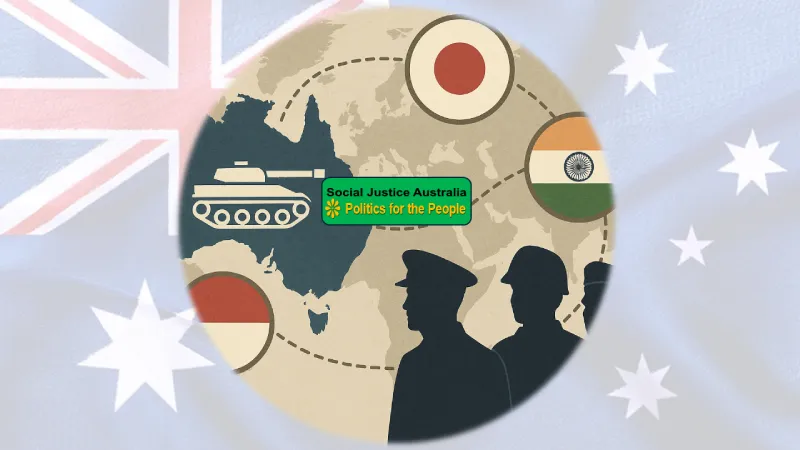Description
US dependence. Discover real steps Australia can take to diversify defence, diplomacy & trade while using its currency power to reclaim sovereignty.
Introduction: A Turning Point for Australia
Location: Canberra, 2024. The Defence Minister stands before cameras, repeating familiar rhetoric: “The US alliance is central to Australia’s security.” But in community halls, cafés, and public forums across the nation, a growing number of Australians are beginning to ask: What if it’s not?
Thoughts: Many Australians feel a quiet unease about our nation’s strategic direction. We’ve followed the US into war zones, hosted its military bases, and allowed our foreign policy to align too closely with American interests. Yet few alternative paths are ever seriously discussed in public debate.
Emotions: There’s frustration, even disillusionment. Australia is a sovereign nation. Why then do we act like a client state?
Dialogue: “It’s not anti-American to want independence,” says Jenny, a retired diplomat. “It’s just good strategy.”
Problem: The Australia-US alliance has become a crutch. While it served a purpose post-WWII, the world has changed. The Indo-Pacific is more multipolar than ever. To secure a peaceful, just future, Australia must explore new defence partnerships, deepen regional diplomacy, and reshape trade alliances. Critically, we must use our monetary sovereignty to do this independently, not through the profit-driven mechanisms of public-private partnerships.
The Problem: Locked into a Narrow Strategic Path
Following WWII, Australia signed onto ANZUS, believing American power would guarantee our safety. But since then, Australia has:
• Participated in every major US-led conflict since Vietnam.
• Spent billions hosting US military infrastructure (like Pine Gap).
• Aligned its foreign policy with US military objectives, often at odds with neighbours.
Meanwhile, the security landscape has shifted:
• China, India, and ASEAN nations now influence the Indo-Pacific.
• US influence is declining, with unpredictable leadership changes.
• Regional cooperation, not superpower allegiance, is the new path to peace.
Real Example: The AUKUS submarine deal, projected to cost over $368 billion, ties Australia into US military logistics for decades—yet those funds could be spent on domestic defence innovation, regional aid, or green manufacturing.
Internal Reflections: “Why are we borrowing American power when we have the capacity to build our own?”
Note on Defence Think Tanks: When assessing defence strategies, it’s important to consider the source. The Australian Strategic Policy Institute (ASPI), often referenced by the government and media, receives funding from the Australian Department of Defence, foreign governments, and major US arms manufacturers such as Lockheed Martin and Northrop Grumman.
These financial ties raise serious concerns about bias in ASPI’s advocacy for militarised solutions and deepening reliance on the US military-industrial complex.

Heightened Risk Through US Dependence: By embedding ourselves in the strategic priorities of the United States, Australia risks becoming a target in conflicts that are not of our making.
Should tensions escalate between the US and China, Australia’s hosting of American military bases, integration into US-led command systems, and participation in initiatives like AUKUS make us more—not less—vulnerable to retaliation.
Instead of ensuring protection, over reliance on US dependence could make Australia a frontline state in the event of a major geopolitical confrontation. The risk is amplified when one considers the United States’ long and well-documented history of military interventions, regime change operations, and aggressive foreign policy—often justified under the banner of “freedom” but resulting in destabilisation, displacement, and long-term suffering in regions such as Iraq, Vietnam, Libya, and Afghanistan.
The Consequences of Strategic US Dependence

Imagine you’re a young Pacific Island leader sitting across from an Australian diplomat in 2030. Rising seas threaten your nation, yet Australia prioritises nuclear submarines over climate aid. “You talk about friendship,” she says, “but you act like a US outpost.”
This isn’t just geopolitical optics:
• Australia risks alienating regional neighbours.
• We are perceived as an extension of Western military ambitions.
• The economic burden of defence decisions like AUKUS will fall on future generations.
Stat: 56% of Australians in a 2024 Lowy Institute poll said Australia should remain neutral in a US-China conflict. The people are ahead of the policymakers.
Diversifying Alliances Through Sovereign Action
Diversifying Defence Partnerships
1. Strengthen Ties with Regional Powers
Japan: Australia and Japan already have a strong relationship, but the Reciprocal Access Agreement (RAA) signed in 2022 offers a new level of cooperation. It allows Australian and Japanese defence forces to train and operate on each other’s territory. Expanding this agreement would mean more joint training exercises, maritime patrols, and technology sharing. Japan shares many of Australia’s concerns about regional stability, especially around the South China Sea. By deepening our alliance with Japan, we can enhance regional security without relying solely on US command.
India: As the world’s largest democracy and a growing global power, India is a natural partner. Both countries are part of the Quadrilateral Security Dialogue (Quad), alongside the US and Japan. However, the Quad doesn’t have a standing military part. Australia can work bilaterally with India to set up an Indo-Pacific Security Corridor—a network of logistics, cybersecurity cooperation, joint naval exercises, and mutual disaster response. India is particularly interested in countering piracy, terrorism, and supporting freedom of navigation—all areas where Australia can contribute.
Indonesia: As our closest neighbour and the largest country in Southeast Asia, Indonesia is vital to any regional defence strategy. Historically, military cooperation between Australia and Indonesia has been cautious due to political sensitivities. But there is growing recognition on both sides of the need for deeper ties. Australia can propose enhanced maritime coordination, shared surveillance of sea lanes, and joint disaster relief programs.
Increasing transparency in military planning and offering officer exchange programs can help build trust and cooperation between our two nations. However, Australia must also use its influence to discourage the misuse of military power in the region. This includes raising concerns over Indonesia’s ongoing human rights abuses and militarisation in West New Guinea, where Indigenous populations have long suffered under state violence.
Any deepened partnership must be conditional on upholding international human rights and civilian protection standards.
2. Engage in Multilateral Defence Forums
• Five Power Defence Arrangements (FPDA): Revive and modernise cooperation with Malaysia, Singapore, New Zealand, and the UK.
• ADMM-Plus: Use ASEAN-led platforms for inclusive, multipolar defence engagement.
3. Invest in Domestic Defence Capabilities with Public Money
• Build Sovereign Industries: Fund shipbuilding, aerospace, cybersecurity, and defence innovation directly through public institutions, not profit-driven PPPs.
• Use Monetary Sovereignty: As the issuer of its own currency, Australia does not need to “find the money”—we can choose to fund defence through targeted public investment, ensuring strategic independence and job creation.
“Australia has the skills and resources to build its own security framework. What’s missing is the political will to act,” argue many independent defence analysts and public policy researchers.
Strengthening Regional Diplomacy
1. Deepen Engagement with Southeast Asia
• Offer infrastructure and education aid through public funding.
• Support ASEAN-led peace building initiatives.
• Show respect for non-aligned values.
2. Build Relationships with Pacific Nations
• Provide real climate action support, not military posturing.
• Co-develop renewable energy projects with island nations.
Location: In 2025, Australia committed $100 million to support the Pacific Resilience Facility (PRF), a regionally led initiative designed to help Pacific nations prepare for and recover from climate-related disasters.
According to Pacific Islands Forum Chair Mark Brown, the PRF will be operational by 2025 and will provide targeted funding for resilience projects in vulnerable communities. This shift toward publicly funded, locally driven resilience initiatives marks a new era of collaboration.
3. Leverage Soft Power
• Invest in ABC International to broadcast public diplomacy across Asia.
• Expand university scholarships and arts diplomacy to win hearts and minds.
Reshaping Trade Alliances
1. Expand Trade with Ethical Partners
• Finalise and deepen trade deals with India, Brazil, South Africa, and Southeast Asia.
• Prioritise mutual benefit, environmental sustainability, and human rights.
2. Reduce Overdependence on Major Powers
• Diversify supply chains for pharmaceuticals, technology, and energy.
• Encourage local production through public sector support.
3. Invest in Future-Focused Industries
• Use public money to build up renewables, green hydrogen, advanced manufacturing, and AI.
• Fund through deficit spending when needed—Australia’s sovereign currency allows it.
“We can create the future we want,” says economist Dr. Julia Grant. “But only if we stop pretending, we’re broke.”
A Sovereign Path Forward
Australia stands at a crossroads. We can either:
• Continue down a narrow, US dependence, dictated by foreign interests.
• Or forge a sovereign strategy rooted in regional peace, domestic innovation, and global cooperation.
With monetary sovereignty, strategic independence is not only possible—it is essential.
Q&A Section
Q1: Can Australia afford to diversify its defence strategy?
Yes. As a currency sovereign, Australia can issue the public money needed to fund new defence and diplomatic directions without relying on profit-driven PPPs or foreign debt.
Q2: Would moving away from the US dependence make Australia vulnerable?
No. Diversifying doesn’t mean abandoning—it means expanding. Strengthening ties with neighbours and global south countries can make us safer, not more exposed.
Q3: How can everyday Australians support this shift?
By demanding that politicians fund diplomacy, education, innovation, and aid over weapons. Engage in public forums, vote for independents, and support regional peace movements.
Call to Action
If you found this article insightful, explore more on political reform and Australia’s monetary sovereignty at Social Justice Australia. :https://socialjusticeaustralia.com.au/
Share this article with your community to help drive the conversation toward a more just and equal society.
Click on our “Reader Feedback”. Please let us know how our content has inspired you. Submit your testimonial and help shape the conversation today!
Additionally, leave a comment about this article below.
Support Social Justice Australia – Help Keep This Platform Running
Social Justice Australia is committed to delivering independent, in-depth analysis of critical issues affecting Australians. Unlike corporate-backed media, we rely on our readers to sustain this platform.
If you find value in our content, consider making a small donation to help cover the costs of hosting, maintenance, and continued research. No matter how small, every contribution makes a real difference in keeping this site accessible and ad-free.
💡 Your support helps:
✅ Keep this website running without corporate influence
✅ Fund research and publishing of articles that challenge the status quo
✅ Expand awareness of policies that affect everyday Australians
💰 A one-time or monthly donation ensures Social Justice Australia stays a strong, independent voice.
Thank you for being part of this movement for change. Your support is truly appreciated!

